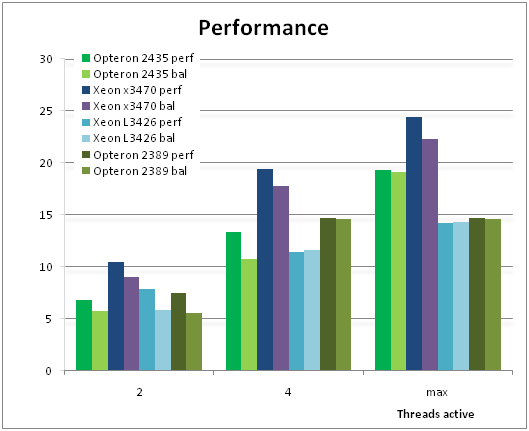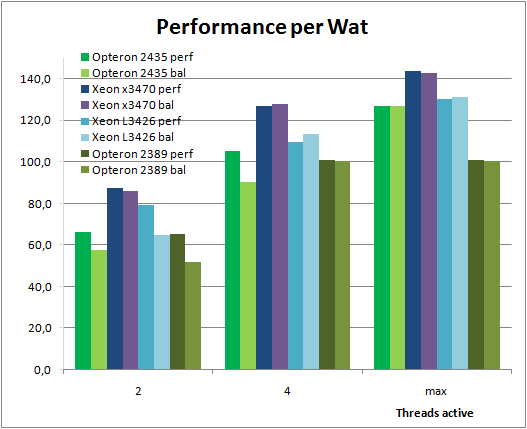Dynamic Power Management: A Quantitative Approach
by Johan De Gelas on January 18, 2010 2:00 AM EST- Posted in
- IT Computing
Overview
So let's summarize what we have seen so far. First we look at system power.

At the system level, the power savings of the Balanced power plan are pretty disappointing. Especially when benchmarking with two threads, we would have expected better power savings. Of course, we tested with only one CPU. The power savings should be better as you add more CPUs to the server. On the X3470 power savings are better, but the reason is not so much "SpeedStep" but more the fact that this turns off Turbo Boost. The most spectacular power savings cannot be seen in this picture: the automatic power and clock gating. As we have shown in this article, power and clock gating happen in both power plans and are responsible for some very significant savings, especially on the "Nehalem Lynnfield" Xeons. SpeedStep and PowerNow! are no longer very impressive for the following reasons:
- Clock gating and "deep sleep" core C-states already save a lot of power
- They are limited to frequency scaling; voltage scaling is only possible if all cores are running at a low P-state
In the case of Intel, frequency scaling is demoted to a pretty insignificant role: it is more important to power gate cores than to clock them down to a lower P-state.

For AMD, P-state changes are still important, but their effect is dubious: performance is up to 20% lower. Even the specific AMD driver in Windows 2008 (amdppm.sys) is not capable of working optimally under low load. Cores frequently stay at 800MHz too long or only get to 1400MHz before a thread is moved to another core. Ideally our two thread benchmark should get at least two CPU cores to quickly ramp up to 2.6GHz and stay there, but that's not what happened in our tests.
We'll make a simple performance/watt calculation by multiplying the performance numbers by 1000 and dividing them by our power numbers.

Look at the green bars of the AMD Opteron processors: performance/watt is clearly lower when running in Balanced mode. This is of course not the case when we run four threads on the quad-core and six threads on the six-core Opteron. In that case the operating system gets very few chances to drop the power. Still, it is important to note that PowerNow! results in a significant performance loss, a performance loss that is not justified by the meager power savings. The result is that the six-core Opteron in Performance mode offers the best performance/watt ratio when we focus on the Opteron family. It is a shame that the Windows 2008 CPU driver does not adapt better: the six-core Opteron is pretty competitive in performance/watt.
The situation is a lot more complex in the Intel Xeon family. With low thread counts, the Xeon is capable of using Turbo Boost. From a "system power" perspective, power is only a bit higher, while performance goes up by a third. But with low TDPs, there is little wiggle room, and Turbo Boost is quickly put out of action. With more than two threads, the L3426 never clocks above 1.86GHz. With "normal" Xeons, there is no significant difference between the two power plans.










35 Comments
View All Comments
n0nsense - Monday, January 18, 2010 - link
Here is what system sees ...only one is 2.5, other three are 2.0 :)
nons ~ # cat /proc/cpuinfo
processor : 0
vendor_id : GenuineIntel
cpu family : 6
model : 23
model name : Intel(R) Core(TM)2 Quad CPU Q9300 @ 2.50GHz
stepping : 7
cpu MHz : 2497.000
cache size : 3072 KB
physical id : 0
siblings : 4
core id : 0
cpu cores : 4
apicid : 0
initial apicid : 0
fpu : yes
fpu_exception : yes
cpuid level : 10
wp : yes
flags : fpu vme de pse tsc msr pae mce cx8 apic sep mtrr pge mca cmov pat pse36 clflush dts acpi mmx fxsr sse sse2 ss ht tm pbe syscall nx lm constant_tsc arch_perfmon pebs bts rep_good pni dtes64 monitor ds_cpl vmx smx est tm2 ssse3 cx16 xtpr pdcm sse4_1 lahf_lm tpr_shadow vnmi flexpriority
bogomips : 5009.38
clflush size : 64
cache_alignment : 64
address sizes : 36 bits physical, 48 bits virtual
power management:
processor : 1
vendor_id : GenuineIntel
cpu family : 6
model : 23
model name : Intel(R) Core(TM)2 Quad CPU Q9300 @ 2.50GHz
stepping : 7
cpu MHz : 1998.000
cache size : 3072 KB
physical id : 0
siblings : 4
core id : 1
cpu cores : 4
apicid : 1
initial apicid : 1
fpu : yes
fpu_exception : yes
cpuid level : 10
wp : yes
flags : fpu vme de pse tsc msr pae mce cx8 apic sep mtrr pge mca cmov pat pse36 clflush dts acpi mmx fxsr sse sse2 ss ht tm pbe syscall nx lm constant_tsc arch_perfmon pebs bts rep_good pni dtes64 monitor ds_cpl vmx smx est tm2 ssse3 cx16 xtpr pdcm sse4_1 lahf_lm tpr_shadow vnmi flexpriority
bogomips : 7012.69
clflush size : 64
cache_alignment : 64
address sizes : 36 bits physical, 48 bits virtual
power management:
processor : 2
vendor_id : GenuineIntel
cpu family : 6
model : 23
model name : Intel(R) Core(TM)2 Quad CPU Q9300 @ 2.50GHz
stepping : 7
cpu MHz : 1998.000
cache size : 3072 KB
physical id : 0
siblings : 4
core id : 2
cpu cores : 4
apicid : 2
initial apicid : 2
fpu : yes
fpu_exception : yes
cpuid level : 10
wp : yes
flags : fpu vme de pse tsc msr pae mce cx8 apic sep mtrr pge mca cmov pat pse36 clflush dts acpi mmx fxsr sse sse2 ss ht tm pbe syscall nx lm constant_tsc arch_perfmon pebs bts rep_good pni dtes64 monitor ds_cpl vmx smx est tm2 ssse3 cx16 xtpr pdcm sse4_1 lahf_lm tpr_shadow vnmi flexpriority
bogomips : 5009.08
clflush size : 64
cache_alignment : 64
address sizes : 36 bits physical, 48 bits virtual
power management:
processor : 3
vendor_id : GenuineIntel
cpu family : 6
model : 23
model name : Intel(R) Core(TM)2 Quad CPU Q9300 @ 2.50GHz
stepping : 7
cpu MHz : 1998.000
cache size : 3072 KB
physical id : 0
siblings : 4
core id : 3
cpu cores : 4
apicid : 3
initial apicid : 3
fpu : yes
fpu_exception : yes
cpuid level : 10
wp : yes
flags : fpu vme de pse tsc msr pae mce cx8 apic sep mtrr pge mca cmov pat pse36 clflush dts acpi mmx fxsr sse sse2 ss ht tm pbe syscall nx lm constant_tsc arch_perfmon pebs bts rep_good pni dtes64 monitor ds_cpl vmx smx est tm2 ssse3 cx16 xtpr pdcm sse4_1 lahf_lm tpr_shadow vnmi flexpriority
bogomips : 5009.09
clflush size : 64
cache_alignment : 64
address sizes : 36 bits physical, 48 bits virtual
power management:
VJ - Tuesday, January 19, 2010 - link
These are mobile CPUs, however:With Linux on a Latitude (Intel T7200 or T7500), CPU Frequency Scaling Monitor allows one to scale the frequency of one core to its max while leaving the other core at its minimum.
With an AMD TL62, this is not possible. The induced scaling of one core causes the frequency of the other core to follow.
With an AMD ZM84 this is possible. Just like with the Latitude, one can have one core at its max with the other core at its minimum.
Maybe what's shown is not what's taking place.
Additionally;
http://www.intel.com/technology/itj/2006/volume10i...">http://www.intel.com/technology/itj/200...al_Manag...
"For example, in a Dual-Processor system, when the OS decides to reduce the frequency of a single core, the other core can still run at full speed. In the Intel Core Duo system, however, lowering the frequency to one core slows down the other core as well."
VJ - Tuesday, January 19, 2010 - link
Additionally; AMD's ZM84 allows each core to operate at different frequencies. The lowest frequency is 575Mhz while the highest is 2300Mhz.I can set one core to 1150Mhz with the other set at 2300Mhz. This is different from the Intel (Mobile) CPUs I've come across where a difference in frequency between cores is only possible when one core is (seemingly) operating at its lowest frequency (in a dual core system).
What is also interesting from aforementioned cpuinfo output is that only core is running at its max frequency while all (3) other cores are (seemingly) at their minimum frequency. Considering my previous conjecture on C2 and C0 states, it would be surprising if one can show cpuinfo output where 2 cores are running at max frequency while the other 2 cores are running at any frequency other than max frequency. That shouldn't be possible at all.
valnar - Thursday, May 6, 2010 - link
Does anyone know if this kind of power management for Lynnfield processors is available in Windows 2003?hshen1 - Sunday, June 23, 2013 - link
This is really a good article for power management researchers like me!!